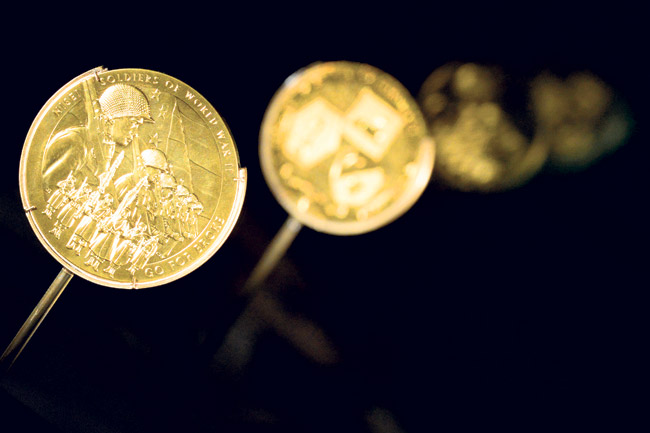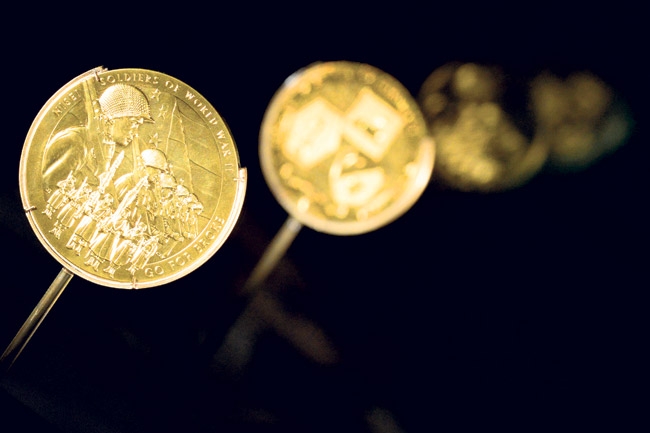Patriotism Proven
A new Bishop Museum exhibit, as well as public events, take an in-depth look at Hawaii’s WWII heroes
“I don’t want any of them (persons of Japanese ancestry) here. They are a dangerous element. There is no way to determine their loyalty.” – U.S. Army Lt. Gen. John L. DeWitt, 1943
What is the price of patriotism? How much should one sacrifice to show unfettered loyalty to one’s country? Are life and honor fair trade-offs in the name of American patriotism?
One cannot help but ponder this ideal while viewing the current “American Heroes: World War II Nisei Soldiers and Congressional Gold Medal” exhibit at Bishop Museum.
Each item on display, including letters from youngsters addressed to the nisei veterans, speaks to the American conscience about the paradox of war. Bravery is cloaked in sacrifice.
The prestigious centerpiece of the exhibit is a striking Congressional Gold Medal that is on an exclusive seven-city tour from the Smithsonian Institution. Be sure to see it before it leaves Honolulu April 14.
The specially designed medal, the nation’s highest civilian award, is a tribute to the thousands of Japanese-Americans of the 100th Infantry Battalion and 442nd Regimental Combat Team, affectionately known as the “Go For Broke” unit.
The exhibit, which formally opened March 9, is a retrospective on one of the darkest chapters of America’s wartime history. The 1941 Japanese attack on Pearl Harbor, well-documented in the annals of history, overshadows an equally dramatic story of the Japanese-Americans who were ostracized as enemy aliens.
Bishop Museum’s American Heroes exhibit is an opportunity to bring legend into reality. The heroism of Hawaii’s nisei soldiers, who volunteered for military service to show the U.S. government their loyalty, comes to life with panel discussions and films that augment the main exhibit at Castle Memorial Building.
One will very likely encounter family members and nisei veterans viewing the exhibit. After all, this is their story.
At the March 9 opening-day ceremony, Jeanne C. Ishikawa, city deputy director of parks and recreation representing Mayor Kirk Caldwell, reflected on her personal connection to the occasion. She acknowledged several family members, including her father, George C. Ishikawa, who served bravely in the World War II conflict.
In a letter to his family from Camp Shelby, Ishikawa wrote: “Our training is tough and rugged. All of this and more are difficult to endure, but we and our comrades carry on cheerfully because we know in our hearts that you folks at home remember us and appreciate what we are going through. We know that you’re counting on us.”
Artifacts at the museum exhibit recall the brutal battles fought by Hawaii’s soldiers in Europe as well as life at relocation camps such as Honouliuli near Kunia.
Remnants of the Military Intelligence Service (MIS) include a vocabulary list of Japanese words used by the clandestine unit to interrogate prisoners of war and to translate classified documents.
Working in secret, MIS units did not receive recognition until 30 years after the war, when files were de-classified.
“Distinguished in battle, unique in American history and yet humble nearly to a fault, they are the boys of One Puka Puka, ‘Go For Broke’ and MIS,” says Eric Shinseki, secretary of the U.S. Department of Veterans Affairs. Shinseki, a Kaua’i native and former Army chief of staff, says the medal “finally puts things right.”
It took four decades after Japan’s surrender for the U.S. government to grant reparations to Japanese-Americans who had been interned. It took nearly seven decades for Congress to unanimously pass Congressional Gold Medal legislation to honor the nisei soldiers.
Does time heal all wounds?
For the highly decorated veterans of the famed 442nd company, ranging in age today from 80 to 101, history is a fleeting memory. In typical shy, self-effacing style, they dismiss heroics and claim what they did was just carrying out orders expected of them.
The ultimate understatement comes from 100th Infantry Battalion veteran Takashi “Kit” Kitaoka, who says it’s “no big thing.” His son Lloyd Kitaoka counters that sentiment by acknowledging that in his father’s heart, “It is a big deal.”
As the 442nd observes its 70th anniversary, Bishop Museum presents a timely focus on its legacy for present and future generations.
As museum president-CEO Blair Collis puts it, “Patriotism can be everything from being involved in the community to being at the battle-front. It is an unconscious willingness to evaluate circumstances, whether in war or not, and stepping forward to act and take responsibility.”
If one acts as courageously and compassionately as the nisei soldiers and their families, history will no doubt herald it a “big deal.” That’s the price of patriotism.
Bishop Museum’s “American Heroes Congressional Gold Medal” exhibit runs through April 14, 9 a.m. to 5 p.m. Closed Tuesdays. General admission, kamaaina and military discounts apply. For more information, visit bishopmuseum.org.
VOICES OF PATRIOTISM
There are many voices of patriotism that tell their stories in free Saturday programs at the museum through April 13 at Atherton Halau.
March 23, 11 a.m.-12:30 p.m. Loyalty, Patriotism, Perseverance: the 100th Infantry Battalion Story. Panelists: Robert Arakaki, Kenneth Higa, Edward Ikuma, Judge Takashi Kitaoka, Donald Matsuda. Moderator: George Tanabe, Jr.
1-2:30 p.m. “Go For Broke” Soldiers Serving after WWII. Special Film: 100th Battalion combat operations in Iraq. Panelists: Col. (Ret.) Walter Ozawa, Col. Colbert Low, Command Sgt. Maj. (Ret.) Arthur Delos Santos, Command Sgt. Maj. Beau Tatsumura, Lt. Col. Keith Horikawa. Moderator: Maj. Gen. (Ret.) Robert Lee.
March 30, 11 a.m.-12:30 p.m. Military Intelligence War against Japan. Special Film: A Tradition of Honor. Panelists: Mark Matsunaga, Ted Tsukiyama, Herbert Yanamura, Norman Kikuta. Moderator: Barbara Tanabe.
April 6, 11 a.m.-2:30 p.m. Hawaii’s Internment and Role in the Legislative Campaign for Redress. Special film: The Untold Story: The Internment of Japanese Americans in Hawaii. Panelists: Brian Niiya, William Kaneko. Moderator: Carole Hayashino.
1-2 p.m. Okage Sama De: True Stories of Japanese Americans during WWII. Storyteller: Alton Chung.
April 13, 11 a.m.-12:30 p.m. Commitment to Education. Panelists: Joan Funamura, Clayton Kaninau, May Price. Moderator: Ann Mahi







